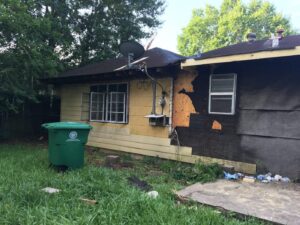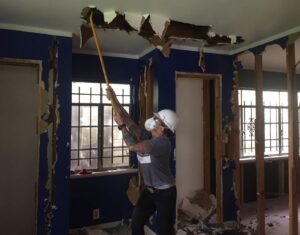Hurricane Harvey may have brought devastation to Houston, Texas, but the corresponding relief and rebuild response has also delivered the opportunity to learn how to build prepared—even before a future hurricane is even on the radar.
This summer, Team Rubicon stepped onto the front lines of homebuilding, adopting a new model for building stronger, more disaster-resilient homes. In June, Team Rubicon began its first Fortified-certified retrofit of a house on Houston’s Tampa Street. Developed by the Insurance Institute for Business and Home Safety (IBHS), Fortified is a set of construction standards and methods designed to help homeowners build or renovate homes to strengthen them against natural hazards like hurricanes, high winds, hail, and severe thunderstorms. Even if a Fortified house is impacted in a storm, it is more likely to fare better, allowing disaster survivors to return to their homes, and their lives, more quickly.
“Team Rubicon is using the Fortified method to create more resilient homes, and to shorten the amount of time it takes to get back to life,” says Chris Cotton, Team Rubicon’s Senior Superintendent of Rebuild, Houston. And the goal is to also ensure those people are getting back into the most resilient homes possible.
New Methods, Not New Materials
Fortified, as a methodology, does not significantly change the construction materials used in home builds, but it does adjust the methods used and the order in which things are installed. Fortified houses, for example, are built with exterior doors that swing outward. Exterior doors configured to swing out during normal operation are beneficial to resiliency in multiple ways.

The Tampa Street house, after Hurricane Harvey, and before Team Rubicon began retrofitting.
“When pressure differentials attempt to equalize in homes where doors swing in, doors are forced open and structures lose their capacity to resist destructive forces,” explains Cotton. “And, when floodwaters impact a home, the weight and pressure produced by floodwater actually force doors that swing outward to close and remain shut.” Outward swinging exterior doors are also less prone to failure in high wind.
Other examples of incorporating Fortified building into homes involves changing not the material used—in roofing, for example—but the installation sequence. Typically, roof drip edges are installed beneath the underlayment at eaves and rake edges. With Fortified, the drip edges are installed on top of the underlayment at both the eaves and rake edges, which prevents wind from getting under the roof, and helps protect the waterproofing. It is a simple change in sequence, but it helps prevent roofs from coming off and inhibits leakage.
“These are simple decisions that strengthen, as well as counteract, forces in high wind and flood events,” Cotton says.
Going for Gold
Fortified certification comes in three formats for both hurricanes and high winds: Fortified Roof, Fortified Silver, and Fortified Gold, with each level serving as an extra buttoning of the hatches, so to speak. The Tampa house passed Fortified pre-inspection this summer; Team Rubicon hopes to know which level the build received when it hands over keys to the home’s owner in mid-October. It could be the state’s first Fortified Gold: In Texas, there are currently no homes with the Hurricane Gold designation and only one, in Austin, with a Gold High Wind designation.

Dani Revette, at work on the Houston home retrofit.
Dani Revette, a Team Rubicon Clay Hunt Fellow Site Supervisor, is working on the Tampa House and recently completed the Fortified inspection—on her first construction job ever. “I know now I only want to build Fortified homes,” Revette said.
Even before taking over the project, Revette was used to a high-pressure work environment: She served three combat deployments during her 13 years in the Navy—always in Special Operations. After leaving the service, she was the only woman on the Tampa, Florida Police Department’s SWAT team. So, she was prepared to learn about construction and Fortified at a rapid pace, and for work in a male-dominated environment. Taking on her first construction project, and overseeing TR’s first-ever Fortified house retrofit, was a relatively easy transition. “I’m comfortable in that world, and no matter what I screw up in this house, I’m not getting shot at,” she says. “And the homeowners are awesome!”
Revette is so taken with the methodology that if she ever builds her own home, she says it will be Fortified.
Team Rubicon may not be the first, or only, builder to adopt the Fortified practice—the city of Houston’s housing department plans to implement Fortified, although Cotton does not know of anyone else in the region adopting it yet. But Fortified will be a large part of Team Rubicon’s rebuild capabilities going forward, whether that is responding to a tornado in Kansas or flooding in Florida.



